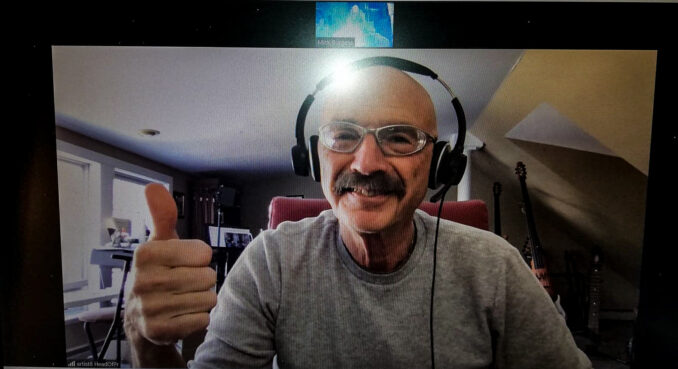
As member of King Crimson for almost 40 years and as part of Peter Gabriel’s band since the ’70s not to mention a session resume that has encompassed working with the likes of Alice Cooper, Buddy Rich, John Lennon, Stevie Nicks, Pink Floyd, Peter Frampton and David Bowie, it’s fair to say that TONY LEVIN, is one of the most in demand bassists in the business. Mick Burgess called him up to talk about reuniting with past and present members of Dream Theater in Liquid Tension Experiment album to make their first album in 22 years.
It’s been quite a strange time for everybody over the last year or so. How has the COVID situation impacted on you?
Of course, we have had no concerts for a long time. It’s almost exactly a year since I played my last show at the end of February of last year. It’s rough for us all. When I start feeling a little sorry for myself, I try to remind myself, it’s much harder for other people because I have my studio and I can make my music here at home and I have a house and a yard. It would be a lot harder if I was in an apartment like a lot of people. I have space of my own, so I can’t complain. I also am very lucky that people send me music pretty regularly that I can play bass tracks to, to be a part of albums. That’s not as much fun as playing live and being on tour but it’s still an outlet for my music. I’m also practising a lot this year because I have the time and because I need to, I need to play better.
Did the lack of touring opportunities open the door to make the new Liquid Tension Experiment album?
Yes, it did. We’re usually always all so busy that it’s very difficult for us all to get together to write and record an album so the lack of touring has given us that time that we need. It’s all happened so fast. It’s amazing to look back at when we were talking about the lockdown year. Being able to make the new Liquid Tension Experiment album is the best thing that happened to me that year, well there’s really two things as I was able to complete a photo book of my photography from all the years on the road. The shining thing is we came up with not just an album but I think a very special one. It wasn’t easy to get together but once we did it was easy. The logistics of getting together in a safe way to write and to record an album wasn’t easy though but the writing and recording was. I’m very pleased that we did this and I feel very good about the result.
What’s the reaction been like to the videos that you have released from the album so far?
So far, we’ve released two videos and the buzz about it is has been very nice. Evidently, we had a lot of fans in waiting who remembered us, even though it’s so many years since we did an album. They seemed excited and we tried to give them the kind of music that we feel we do best, which is pretty exciting and hard hitting.
Does it feel like 22 years have passed since you last got together to make a record?
No, it doesn’t seem that long ago at all. First of all, I think it was Jordan Rudess, our keyboard player, who had the idea. He and Mike Portnoy wrote to me and John Petrucci in June or late May, asking what we thought about us getting together. We were so excited. It only took a day from first hearing the idea until we were making plans. I had booked a hotel and we had booked a studio and we just we had to do it. It was a great idea. You could say the idea was there in the air waiting for somebody to capture it and realise what a great idea was.
How did you feel when you first got met up again in the studio?
It felt great. When we got together in the studio, it really surprised me and I think it surprised us all, how it felt exactly like the first album. Each of us individually can do many styles of music but when us four people are together in a room, all we need to do is roll the tape and start recording and we will compose. The piece will be two minutes long at first then it’ll be five minutes then it’ll be 10 minutes and then it’ll be 15 minutes. It just happens organically, in a natural way. We don’t have to try. We don’t have to think about what we did before. We never have those conversations. We just say “Hey, how about this idea?” and then it becomes Liquid Tension Experiment. It becomes what the band is.
How long passed from the first suggestion of doing a new album to actually getting together in a room to work together?
I’m guessing the beginning of June to the middle of July so it was about six weeks. We just we needed to reserve a studio and hotel rooms and make a plan for us each to be tested for COVID and form a bubble in a safe way. One of the hardest things was finding a hotel as it had to have a back entrance where I could get to the room without encountering anybody else and things like that. They seem silly and you don’t want to have to think about it but it is important to take care.
Where did you do the recording?
The studio was on Long Island, which is for me, maybe two or three hours away. I only had one trip to make with my instruments in my car so I had a very interesting time as a bass player trying to decide which of my basses to bring. In a perfect world, I would have had 10 of them there. It was interesting, especially bringing the electric upright bass, which is probably the last instrument you would bring to a Liquid Tension Experiment record but it was a sort of a wild card idea. I thought I’d just have it in the room with me as you never know. It turned out when I was improvising one night, it was just me and Mike Portnoy and he played something that made me reach for that bass and it ended up on a piece called “Chris and Kevin’s Amazing Odyssey”. This is a band that that loves to improvise and so in the end, I was really glad that I brought that bass even though it seemed like a silly extra thing to have at the time.
There are eight tracks on the album. Were these all written from scratch for the album or did you have some ideas left over from your second album?
We can’t even remember the second album, it was so long ago. It was all absolutely written from scratch although maybe John and Jordan did have some riffs that we worked on and they would lead to other riffs and they’d turn to me and ask me to play a bass line in a certain key so one thing lead to another. It was all very organic and I think as a band we write very quickly. It was a two-to-three-week process to write the album and to record it but you have to bear in mind there’s a bonus CD with another album’s worth of material too.
How did the intervening 22 years impact on your song writing? Did you approach things differently this time?
First of all, we didn’t think about that. I think we were really shocked how it was the same. I don’t mean the music was the same but the process was the same. We try to change and do something different, we just played music and the music came out as it came out. I like bands that have a distinctive flavour of their own and I think, somehow, we automatically have that when the four of us get together. It’s not a given that, that would happen as we can all play a lot of different styles. We could get together and make a Jazz album or a Heavy Rock album but without discussing it, when it’s just the four of us, it just happens this way.
Which was the first song that you wrote together after 22 years?
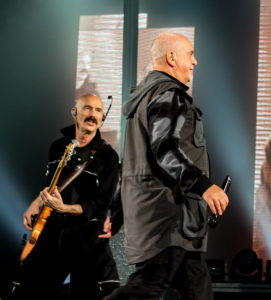
That’s a good question as I’m looking at the list of songs and I don’t remember. I think we’re like any band, when we write a piece, we just make up a name. I know the name of the first piece, “Song One” and the next was called “Song Two”. It’s only much later that they are given proper names and somebody other than me named them. It’s the same with Peter Gabriel and King Crimson, a song will have its working title and then sometime later it’ll be given its proper name and someone like me won’t know what they’re talking about. We haven’t gone on tour yet so I haven’t had to learn that this song title is what I knew originally as “Song One”.
You’ve done an interesting cover of Gershwin’s “Rhapsody in Blue”. Why did you decide to cover that tune?
When we toured in 2008, we did a very short, very jam based tour of seven shows in seven days. It was only a week before that when Mike Portnoy suggested to us that we do “Rhapsody in Blue”. I was amazed that Jordan Rudess could be asked to learn essentially a piano concerto and then to change it and make it a Metal version. It was really something and we did it quite well live. I’m not sure if it made it onto a live album or not. I think in the middle of recording the latest album somebody mentioned that piece. I know I was a big fan of it and I voted that we at least tried to do that with the same arrangement that we had worked on years before. The reason I love the piece is that I come from a Classical background originally and the piece goes in a lot of directions for Classical music and I think Liquid Tension Experiment is that kind of band. We also play in a lot of ways we do improv, spacey things, powerful Metal things, we do some Jazz sections, some Honky Tonk, so we could bring all of that to this Gershwin piece. In my opinion, we could take it in as many directions as it deserves to be taken. I was a fan of it for that reason. The second reason is, some of my family and some fans of mine are not particularly fans of speed Metal so they have mixed feelings about Liquid Tension Experiment. This piece is like the gateway drug that they can all enjoy. I can play them a piece where we maybe don’t go crazy. Frankly with the Liquid Tension we have some wonderful melodic, symphonic or anthemic sections that you are always singing to yourself. After “Rhapsody in Blue”, I can play them another piece and slowly draw them into the band.
One of the standout tracks on the album is the last one, “Key To The Imagination”, with elements of Funk and eastern influences which goes through many moods and tempos.
I really like that one. It has a lot of different sections. It gets very big, it gets very heavy and it has a bass solo which is very unusual for me. In one section I did an unusual technique of playing with my fingernails and that was a kind of cool sound. I love that it starts with the piano alone. I really like it when you end the piece, really with a sense of who each of the musicians is as a player and that’s good. One likes to have the unique things about each player come out in each piece.
Did you consider holding the songs on the bonus disc back for Liquid Tension Experiment’s next album so you could get off to a flying start rather than waiting 22 years for the next one?
That’s a very good question and one that makes me smile. Improvising is a big part of the band. We certainly compose and we certainly play the solos over things that are composed but we also like to improvise in our live shows and on our albums. We would work from about 10 or 11 in the morning until 10 at night and that was a rule for ourselves so it didn’t get crazy and exhausting. However, if we were finished doing what we could with the compositions at 9 o’clock, then all four of us or maybe just two of us would go back in the room and roll the tape to start recording and just improvise and we’d have no rules. We did that a lot and after two weeks we had a wealth of improvs, some of which could lead to a section of a piece and some were used as pieces by themselves. I think there are two or three pieces on the album that were complete improv and somebody went in to the studio and listened to all of it and culled the best of it and decided to make a second CD. That was really all improv but it doesn’t sound like it because we have a way of sounding like it’s composed a little bit one way. The bonus CD is called A Night At The Improv and it features a whole bunch of sections of improv.
Did you work with a producer then or did your self-produce it?
We self-produced the album. I’m going to say to be fair, that I’m scuffling to play a good bass part on everything. It’s really mostly the other three guys who did the production. You could tell that already because I don’t know the song titles and I don’t know where the sections of the improv are culled from.
Are you planning on doing anything to mark its released like maybe a live stream perhaps or some sort of event.
Not that I know of but there’s going to be one more video, for “Hypersonic” and that’ll be pretty special.
What does Liquid Tension Experiment allow you to do musically, that you can’t do in any of the any of your other bands or side projects?
That’s a good question and I’ve never thought about it that way. I’m not sure I have an answer. I can certainly be free and improvise but then I can do that in some other bands. I think the reason I don’t have a good answer for that is because I’m in a lot of bands. If I was only in King Crimson, and I love King Crimson, it’s very challenging but there’s seven players in King Crimson, there isn’t the room or space that Liquid Tension gives me to really do everything I want. I can go in any direction I want in King Crimson but the appropriate directions usually don’t involve nearly as many notes as that I can play in Liquid Tension. The Stickmen only has three players. Marcus Reuter is another touch guitar player and I play only with the Chapman stick in it. Pat Mastelotto of King Crimson is our drummer and we intentionally keep it as a small band. There’s room for each of us to explore and do a lot. Plus, we do at least one or two, total improvs in each show. So that’s a band that has a lot of room for improvising.
Do you hope to do some touring with Liquid Tension Experiment when things start getting back to normal?
On the subject of touring the nature of this kind of band where all the guys are in other bands, we always want to tour but it’s very complex. The planets have to align the right way. Between us we are involved with Dream Theater, King Crimson, The Stickmen and Peter Gabriel and Mike Portnoy alone is in a dozen bands so we all have to know a year ahead of time that we’re going to have a break. It doesn’t need to be long, but we all need that break at the same time to be able to tour together. Should that happen, we will be most excited to book a tour and I would predict, although I know better than to predict with Rock ‘n’ Roll, but I would predict that sooner or later we will do a tour, but certainly not on the release of the album. Obviously, you can’t tour now. We can’t even do the tours we have booked, I know I have two King Crimson tours booked this year and a Stickmen tour. Even those tours we don’t know for sure if they can happen. If they don’t, then they’ll spill over into next year and they’ll get rescheduled. It could be a while until we can tour.
You have just published a photo book called Images From Life On The Road. How long has this been in the making?
The photos I’ve been taking forever, since the earth cooled, since I started touring. I got better at photography through the years, of course as anybody would. In the last 10 years, I’ve realised that some of these photos are really special, not because I’m a great photographer, but because I was lucky to be in a certain place at a certain time. I had a vantage point that nobody else had, let’s say, being on stage when Peter Gabriel started to fall into the audience and do what later was called crowd surfing during “Lay Your Hands On Me” and there I was taking his photo. I started feeling that these photos really deserve to be shared. It’s one thing putting them up on my web diary but they really deserve a book and a big book, not just a little paperback but a coffee table type of book. That was the back of my mind.
Was this another project that you were able to do during the lockdown?
It was really impossible to find the time to collate all of those literally tens of thousands of negatives and transparencies of different styles. I wasn’t wise enough to stick with the same type of film or anything like that through the years. Anyway, it took a lot of time to collate and so a month into the lockdown around last May, I realised I could either do a solo album with this unlimited amount of spare time in front of me or I could actually tackle that book and start going through the negatives and scanning them. I started at the beginning of June and spent many hours each day until December every day. I haven’t added up the hours but it’s a lot. First of all, to see which pictures were worth it. If it was a negative that meant printing them and scanning things like that.
How did you plan to present these photos in your book?
I wanted to try to put the book together in a coherent way that is more than just OK, here are the pictures, I considered doing them chronologically across my career or maybe band by band with sections on King Crimson and Peter Gabriel. I ended up trying to make it feel like a visit to what the road is like. There are chapters of fans travelling to the venue and then pictures of backstage at the venue and frankly a lot of dramatic stuff happens backstage and it’s kind of fun to see that. Then there’s photos onstage and bowing and things like that.
What were the most challenging photos for you to take?
With Peter Gabriel, he did a piece called “Shock The Monkey” where we each jumped up. Each night, I had the camera on a tripod with a cord coming from it to a squeeze bulb for those of us old enough to remember when a squeeze bulb would trigger the shutter on the camera. I had to focus it and expose it before the show and aim it. Then every time we jumped, I would pick up that bulb in my hand and try and time it and try to arrange it so that I wasn’t in the way of seeing Peter and all that. That only worked once or twice out of the hundreds of times I tried it. In those days I used film that I had to develop on the road. I couldn’t really tell if it worked or not until a week or two later. Things got a lot easier with digital. In the end, if you’re looking at a photo book all that matters is the quality of the photos. I feel wonderful about having finally released that book and to share it with the public and especially with the fans of Peter Gabriel and King Crimson. Incidentally one of the things I regret about my photographic career such as it is, is I changed to digital too early. When I switched completely to digital in the 90s, it was really awful, the pictures were so small. The pictures that seemed worth keeping were about 220 pixels and so when I look at four or five years’ worth of pictures, there’s some great stuff there but I can’t even put it on the web as they are too small.
You mentioned the Chapman stick bass. What made you decide to tackle the Chapman stick?
Well, I got it very early. Emma Chapman invented it, I’m guessing in 1975 or roughly then and I was I was playing plenty in those days and I actually played the bass in those days with a hammer on or tap technique. In late ’75 or ’76 quite a few musicians I worked with said, “Hey, Tony, you know that way you play the bass, you should consider this Chapman stick”, because that’s the way it’s designed to be played. So when I was in Los Angeles, I did get one. I only remember that date because I brought it to the sessions of Peter Gabriel’s first solo album, which was in the summer of 76 so I know, I had it in ’76 although I didn’t end up playing it on that. It’s a wonderful instrument and it’s played very differently. I approached it as a bass from the beginning and I eventually started playing those top strings, but I didn’t even touch them for a few years. I liked it as a bass and I still do because it has a different sound, it has a different technique and it allows me to break out of your patterns and think of other ways to approach the part. It also has a very distinct and powerful sound down low. I can actually play faster down low than I can with a bass and have it really speak clearly. That’s why I used it on pieces like “Hypersonic Conflict” with Liquid Tension Experiment, because it speaks very clearly.
Being in The Stickmen allows you to push it to the absolute limit, doesn’t it? You can just do what you want with it.
I would say it pushes me to my limits for sure.
It was always said that people tend to choose the bass when they’re younger because they had less strings than a guitar but when you look at the Chapman stick, it makes the guitar look like a triangle.
Yes, good point. Ironically, I wasn’t attracted to it because of the multi strings. I just heard it and I liked the sound and I envisioned a way that it would be useful for me and indeed, in ’81, on King Crimson’s Discipline record, I started playing it with the guitar players in in a kind of progressive way. That really worked out.
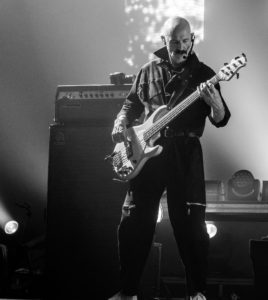
Who were those bass players that you were listening to that first got you into playing the instrument?
That goes way back before your time. I would say that the main one was Oscar Pettiford, a Jazz player in New York City from the 50s. He was around before the 50s but that’s when I was listening to him. My older brother is a Jazz musician and because he’s older he was the one buying records. He was a French horn player and Julius Watkins, a Jazz French horn player, did wonderful records that always had Oscar Pettiford on bass and I was listening to those from the day I got the bass. There are many others, of course over the years first from Jazz and then Rock that inspired me. Now I hear bass players, sometimes I don’t even know their names but I hear them on the web and they do cool things and technical things that I would never imagine and they’re always inspiring me, if not to try to play like them but to try to up my game and to try to grow as a bass player and grow as a musician.
Were you self-taught or did you get lessons?
I was classical player so I was very instructed with a very rigid technique on the upright bass but I dropped some of that when I went to bass guitar. When I moved to New York City and became a studio musician, I had to learn for the first time in my life, not to read music exactly the way it was written, I was the kind of player that if the arranger had written the wrong note, I would play the wrong note, even though I knew it was the wrong note and it sounds silly but I had to retrain myself to play the music that the arranger wants, not what he actually wrote.
What was your first bass?
My first bass was an upright bass. Then I saw an electric bass player who was playing a Fender Precision and I went up after the show, I think it was a Jazz show and I asked him what it was and how could I get one. Can you imagine being so naive? He said it’s called a Fender Bass and he said don’t get a new one, get a used one. Back then, there was no such expression as a vintage one. He said to me a new one is $220 but a used one was $180. I went to New York and he was exactly right about the prices and for $180 I got a 50s Fender Precision, which I don’t have anymore, but if I did it would be worth thousands.
What advice would you give to somebody starting out on bass?
I don’t feel like I’m qualified to give much advice about that. I’ve been so lucky through my career and started so long ago when things were quite different. I would say those of us who can play music for fun are very lucky because it’s such a gratifying thing and those of us who get to then play professionally are even more lucky and really blessed to be able to spend their life doing what they love to do. I think if you attack your instrument and play it a lot, you’ll pretty quickly find out whether it’s something you love so much that it’s all you want to do, which was the case with me and people like me. There isn’t one way to improve as a player, practising is one of them but another one is to play with other players. When you play with better players than you, that’s a great opportunity to become a better player yourself. It’s a little daunting sometimes but I highly recommend playing with the best players as much as you can because you’re only going to get better and the day will come when people are glad to play with you as the better player.
How did you go about developing your unique Funk Fingers approach to playing the bass?
They came about on the Peter Gabriel So album when we started recording the piece called “Big Time”. For some reason or other I asked Jerry Marotta, the drummer, to drum on my bass strings while I did the finger work with my left hand and that became part of the bass line for that song. Then if you fast forward a year to 1986 when I was touring, trying to play that part with one drumstick in my hand, I did a pretty bad job of it. One day at soundcheck when I was practising with the drumstick as usual, Peter Gabriel walked by me and he said these words, ” Why don’t you figure out a way to put two drumsticks on your fingers?” That right there, that was the beginning. It took a little while to get it right and get them the right weight and fit them so not to squeeze my fingers too hard and things like that. A year later, I named them Funk Fingers just for fun. I played them certainly on “Big Time” live but I’ve also played them through the years on a number of other Peter Gabriel and King Crimson songs as well.
A couple of years ago King Crimson performed for three nights at the Royal Albert Hall to mark their 50th anniversary. That must be a real career highlight for you?
That was such a very special moment for me. As I say in the end of my book, to play at the Royal Albert Hall is, under any circumstances, really special. It feels historic just to walk in there and be on the stage. This was not the first time with King Crimson but somehow, it seemed more special even than before probably because it was multiple nights and we felt like we were really at the top of our game and hopefully deserving of being in such an iconic venue.
Most bass players lock in with a drummer to form the basis of the rhythm section. You’ve got three drummers in King Crimson, Pat Mastelotto, Gavin Harrison and Jeremy Stacey. How on earth do you track who to anchor your bass to?
That’s a very good point. As it turns out it’s a challenge but not the challenge that I expected when Robert Fripp had the idea of three drummers. I thought woah boy, this is going to be really something to try to lock in and whose bass drum am I going to hear? There’s a few things. The main thing is that the three drummers are so locked in with each other. They rehearse their parts and they’re fantastically tight. The second thing is we wear in ear monitors. Without those, I don’t think that the band could do what it does live. For instance, Gavin Harrison is so far away from me across the stage that if I was hearing him with the delay that is actually acoustically there, I wouldn’t be able to lock in the way that I am with him. With the in ear monitors I can in control what I’m hearing. I can have the three drummers right in my face all the time if I wanted but I’m in control of what I need. That, plus the fact that they’re so tight as a group makes it not that difficult at all. One of the easier elements of the band is locking in together.
You have played with Peter Gabriel for years both on his studio albums and live and you played on one of the most iconic bass lines of the of the 80s on “Sledgehammer”. How did Peter convey what he wanted from you on that track and did he give you freedom to improvise?
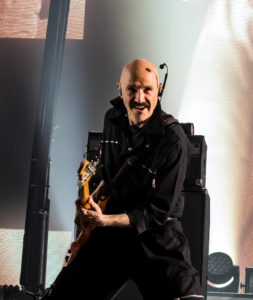
I’ve done so many tracks over so many years for Peter that I can safely say that I am free to play whatever I want. Sometimes he presents me with an idea and he’s happy if I warp it a little bit to suit my bass. It’s a wonderful creative situation for a musician and I know how open minded he is. From the beginning I knew that instead of playing the normal part that I might do, I could think of what else I could do. On “Sledgehammer” the album was pretty much recorded and we were literally, almost packing up when Peter brought out that song for me and drummer Manu Katche. We did that it only a few takes late at night. There was no time to second guess it or try different things which was quite unusual as we normally work on songs at length. That one came very quickly and I don’t know why I chose that combination of octave pedals, fretless bass and a pick, which are three things I don’t usually use along with a lot of compression and that turned into the sound that ended up on the record.
Is that bass line your “Walk On The Wildside” or “Another One Bites The Dust” moment?
I don’t usually think back on what I’ve done, I tend to focus more on what I’m doing at the moment so for now I’m focussed on Liquid Tension Experiment and soon I’ll be rehearsing and practicing for the King Crimson tour in the summer. Unless I’m doing an interview, I don’t really have an awareness of what I’ve done before.
Your CV is quite incredible working with Alice Cooper, Buddy Rich, John Lennon, Paul Simon, Stevie Nicks, Pink Floyd, Peter Frampton, David Bowie, Joan Armatrading, Cher and Bryan Ferry to name but a few. Is it tricky switching between musical styles especially if you’re doing a few sessions in a short space of time?
I’m a typical musician in that respect in that they are good at focussing hard on what they are doing. To play one piece of music requires a presence of mind and focus to play the piece right so I am very focused when I’m doing each session and don’t think about what I have done previously, just on what I’m doing at that moment.
Which one of your sessions over the years stands out for you?
I’ve done so many sessions with so many inspiring artists that it’s really difficult to pick one. They have each inspired me and influenced me in a different way. Just the list of drummers that I have played with for a start is absolutely amazing, so many great players. I think my first professional session was with a Jazz player called Gap Mangione and his drummer Steve Gadd was incredible. All I did then as I still do now, is follow Steve.
What about a new King Crimson album or a new Peter Gabriel album? Is there anything on the horizon?
I know Peter has been talking about an album for quite a while but nothing has happened with that yet but with King Crimson, there is no album. We’re just focussed on our live shows.
Looking forward, what are your plans for 2021 and beyond?
I do a lot of sessions here every day in my home studio for records that are coming out later in the year and next year so I’ll be doing more of those over the coming months. King Crimson have shows booked for a tour of The States in the summer which I hope will happen. In September The Stickmen will tour Europe. I haven’t looked too closely on the exact places we’ll play as I live in fear that it’ll all fall through. Then King Crimson tour again in November and December in Japan and Australia. We’ll be booking the Levin Brothers, a Jazz band, for 2022 and also another Stickmen tour for 2022. In a normal year I could tell you what we are going to do but at the moment I’m just hoping that these can all happen.
Liquid Tension Experiment 3 is out now on Inside Out insideoutmusic.com
Images From Life On The Road is available now.
For more on Tony Levin visit tonylevin.com
Interview and Live Photos By Mick Burgess

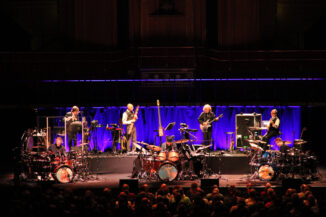
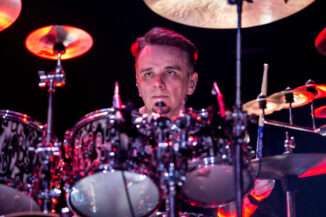
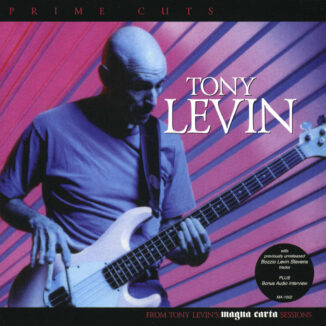
Be the first to comment